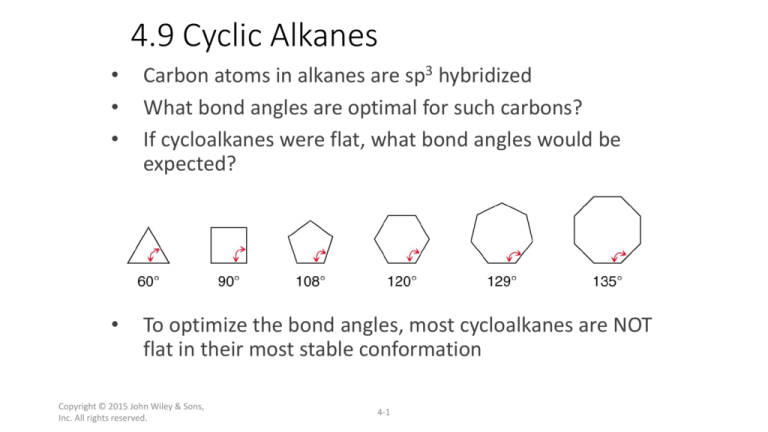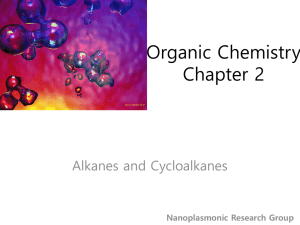
4.9 Cyclic Alkanes
•
•
•
Carbon atoms in alkanes are sp3 hybridized
What bond angles are optimal for such carbons?
If cycloalkanes were flat, what bond angles would be
expected?
•
To optimize the bond angles, most cycloalkanes are NOT
flat in their most stable conformation
Copyright © 2015 John Wiley & Sons,
Inc. All rights reserved.
4-1
4.9 Cyclic Alkanes
•
•
Why are heats
of combustion
reported per
CH2 group?
Considering
the data in
Table 4.7,
which ring has
the least ring
strain?
Copyright © 2015 John Wiley & Sons,
Inc. All rights reserved.
4-2
4.9 Cyclic Alkanes
•
Why does it make a molecule less stable to have angles
less than 109.5°?
•
Why does it make a molecule less stable to have angles
greater than 109.5°?
•
Ring strain results from more than just angle strain
Copyright © 2015 John Wiley & Sons,
Inc. All rights reserved.
4-3
4.9 Cyclopropane
•
Cyclopropane is 44 kJ/mol less stable than cyclohexane
per CH2 group. It is highly strained and very reactive
1. Angle strain
•
•
Bond angles of 60° cause electron
pair repulsion in adjacent bonds
Inefficient sigma bond overlap
2. Torsional strain – eclipsing C-H
bonds all the way around the
ring – see the Newman
projection
Copyright © 2015 John Wiley & Sons,
Inc. All rights reserved.
4-4
4.9 Cyclobutane
•
Cyclobutane is 27 kJ/mol less stable than cyclohexane
per CH2 group. It is also strained and reactive
1. Angle strain results from bond angles of 88°, although it is not
as severe as the 60° angles in cyclopropane
2. Slight torsional strain results because adjacent C-H bonds are
neither fully eclipsed nor fully staggered
•
Why does it adopt a puckered conformation?
Copyright © 2015 John Wiley & Sons,
Inc. All rights reserved.
4-5
4.9 Cyclopentane
•
Cyclopentane is only 5 kJ/mol less stable than
cyclohexane per CH2 group
1. Angles are close to the optimal value
2. Identify the minimal but significant torsional strain in the
structure. It is very helpful to use a handheld model
•
Why does it adopt the envelope conformation rather
than a flat conformation?
Copyright © 2015 John Wiley & Sons,
Inc. All rights reserved.
4-6
4.10 Cyclohexane
•
Cyclohexane is considered to have ZERO ring strain in its
optimal conformation, THE CHAIR
1. No angle strain - angles must be 109.5°
2. No torsional strain - all adjacent C-H bonds must be staggered
•
It helps to make a model as a visual aid! WHY is this
called THE CHAIR?
Copyright © 2015 John Wiley & Sons,
Inc. All rights reserved.
4-7
4.10 Cyclohexane
•
Other conformations of hexane exist but are a bit less
stable. Consider THE BOAT
1.
2.
•
•
3.
•
No angle strain - angles are 109.5°
Torsional strain.
Use a molecular model to identify all four pairs of
eclipsing C-H bonds
Draw a Newman projection that illustrates the
torsional strain
Steric strain – flagpole interactions. WHERE?
Why is this conformation called the BOAT?
Copyright © 2015 John Wiley & Sons,
Inc. All rights reserved.
4-8
4.10 Cyclohexane
Rotate the C-C single
bonds in your
handheld
cyclohexane model to
form each of the
conformations and
analyze its energy
Why is
the halfchair so
unstable?
The twist boat
alleviates some of
the torsional strain
in the boat
Copyright © 2015 John Wiley & Sons,
Inc. All rights reserved.
4-9
4.11 Drawing Chairs
•
It is critical to draw a CHAIR properly. Use three sets of
parallel lines
•
SIX of the atoms attached to the chair are axial. Axial
groups point straight up and down alternating around
the ring.
CORRECT
Copyright © 2015 John Wiley & Sons,
Inc. All rights reserved.
INCORRECT
4-10
4.11 Drawing Chairs
•
The other SIX atoms attached to a chair are in
equatorial positions. Equatorial substituents are
positioned at angles parallel to the sets of parallel lines
making up the chair itself
•
Axial groups shown in red, equatorial groups shown in
blue
•
Practice with SkillBuilders 4.9 and 4.10
Copyright © 2015 John Wiley & Sons,
Inc. All rights reserved.
4-11





